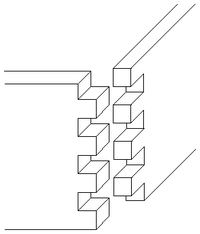- Finger joint
-
A finger joint or comb joint is a woodworking joint made by cutting a set of complementary rectangular cuts in two pieces of wood, which are then glued. To visualize a finger joint simply interlock the fingers of your hands at a ninety degree angle; hence the name "finger joint." It is stronger than a butt or lap joint, and often contributes to the aesthetics of the piece.
Contents
Production
The history of the finger joint is believed to have begun with wooden produce boxes or crates in the days before modern, man-made materials. Finger joints were originally cut by hand with saws and sharp chisels. In modern times they are easily and quickly made with a table saw or router and a jig or fixture, which can be shop-made or purchased from a specialty woodworking supply store. A finger joint jig typically consists of a moving fence with an indexing pin that is used to evenly space out the cuts. The fence is moved over a cutting blade making a cut that is then moved over the indexing pin so the next cut can be made.
While it is relatively easy to make using computer aided manufacture, a table saw or a wood router with a simple jig, some common problems include:
- Tear out on the back side
- If using a table saw, the top of the joint may not be exactly flat, depending on the tooth set of the blade
- Spacing problems and difficulty dialing in the exact index
Properties
The strength of a finger joint comes from the long-grain to long-grain contact between the fingers, which provides a solid gluing surface. The number of contact points also allows for more gluing surface as opposed to a butt joint or a rabbet joint.
While the spacing of finger joints is mostly an aesthetic decision, it is commonly less than or equal to the thickness of the material being joined. For example, one might decide on 1/8" fingers on 1/4" material unless the length of the mating surfaces lends itself better to a 1/4" finger joint, which would appear less "busy" to the eye.
Although finger joints are usually evenly spaced, it's not unusual for woodworkers to experiment with varying spacing between cuts.
Applications
The finger joint is the most common joint used to form long pieces of lumber from solid boards; the result is finger-jointed lumber.
The finger joint can also be invaluable when fixing tables and chairs and also can be used in such things as floor boards, timber roof and door construction. This is also used in design technology for students. Finger joints can be hard to make without the right tools.
See also
References

This article about joinery, woodworking joints, carpentry or woodworking is a stub. You can help Wikipedia by expanding it.

